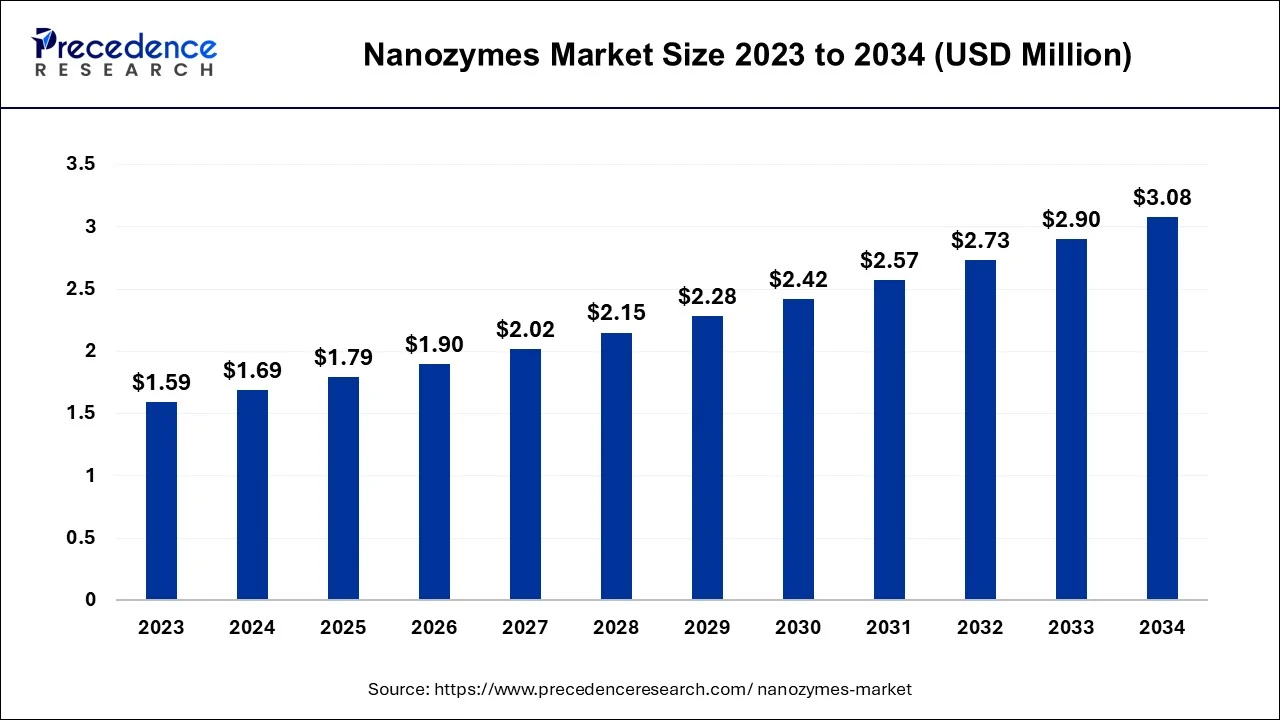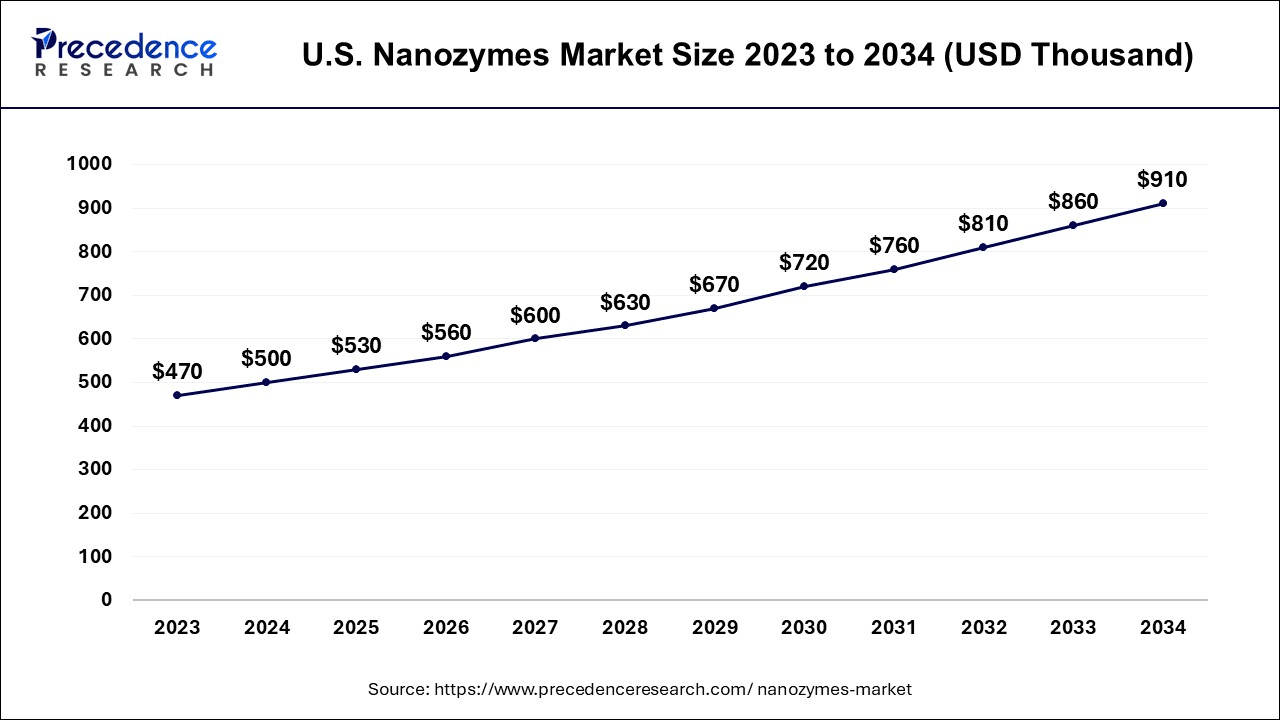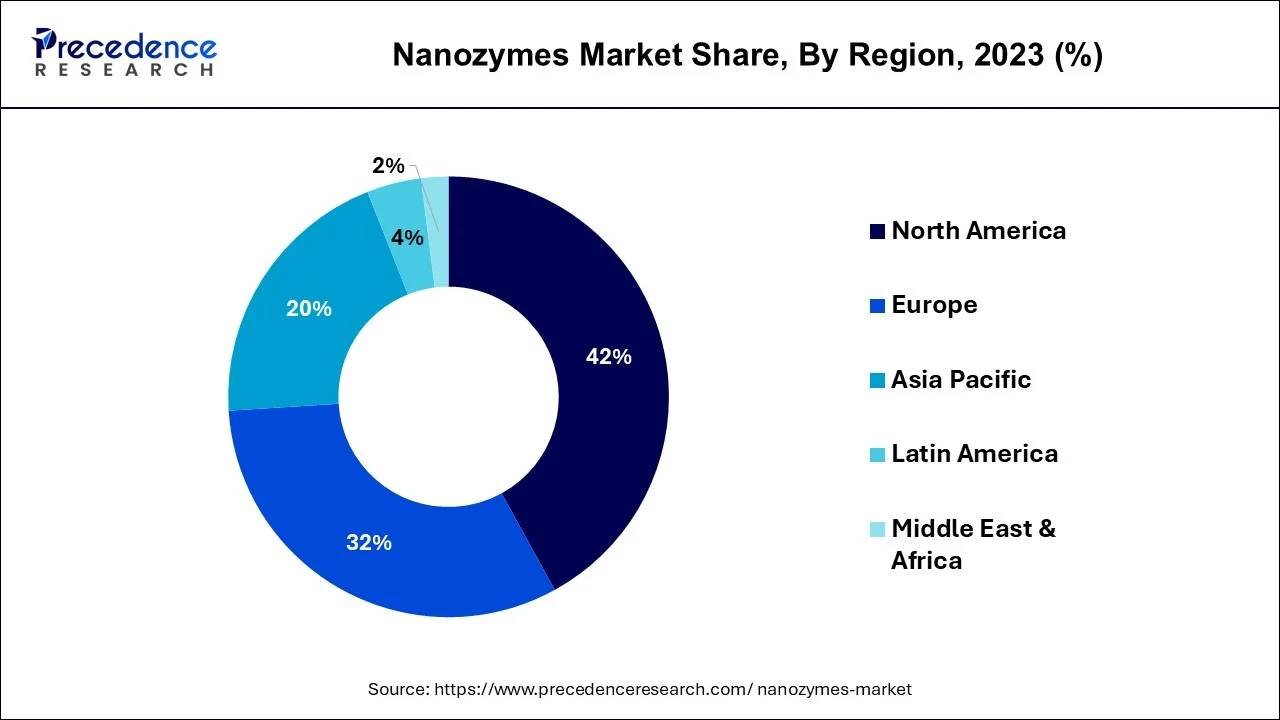The global nanozymes market size is calculated at USD 1.69 million in 2024, grew to USD 1.79 million in 2025 and is predicted to hit around USD 3.08 million by 2034, expanding at a CAGR of 6.19% between 2024 and 2034.
The global nanozymes market size accounted for USD 1.69 million in 2024 and is anticipated to reach around USD 3.08 million by 2034, growing at a CAGR of 6.19% between 2024 and 2034.

The U.S. Nanozymes market size was valued at USD 500 thousand in 2023 and is expected to be worth around USD 910 thousand by 2032, at a CAGR of 6.27% from 2024 to 2034.

North America has held the largest revenue share of 42% in 2023. North America holds a major share in the nanozymes market due to robust research and development activities, a well-established healthcare infrastructure, and increasing investments in nanotechnology. The region benefits from a strong presence of key market players and academic institutions, fostering innovation and technological advancements. Additionally, a high level of awareness and early adoption of novel technologies in healthcare and industry contribute to North America's significant market share in the rapidly growing field of nanozymes.

Asia Pacific is estimated to observe the fastest expansion. Asia Pacific dominates the nanozymes market due to robust economic growth, increased research and development activities, and a surge in healthcare and environmental concerns. The region's proactive adoption of nanotechnology, particularly in countries like China and India, propels nanozymes market growth. Additionally, supportive government initiatives, a burgeoning pharmaceutical industry, and a rising focus on sustainable technologies contribute to the region's major market share. The Asia Pacific market continues to witness significant advancements, fostering innovation and widespread application of nanozymes across diverse industries.
Nanozymes are nanomaterials with enzyme-like properties, combining the advantages of both nanotechnology and enzymology. These synthetic nanomaterials mimic the catalytic activities of natural enzymes, facilitating various biochemical reactions with high efficiency and specificity. Unlike natural enzymes, nanozymes are often more robust, cost-effective, and easier to produce, making them promising candidates for various applications in medicine, environmental remediation, and industrial processes.
In the field of medicine, nanozymes hold great potential for diagnostic and therapeutic purposes. They can be designed to detect specific biomolecules, such as disease markers, with high sensitivity, offering a rapid and accurate diagnostic tool. Additionally, nanozymes can be utilized for targeted drug delivery and controlled release, enhancing the precision and effectiveness of therapeutic interventions. Beyond healthcare, nanozymes are being explored for their role in environmental protection by catalyzing reactions to degrade pollutants. Their versatility and tunability make nanozymes a fascinating area of research with broad-reaching implications for diverse scientific and technological advancements.
| Report Coverage | Details |
| Market Size in 2024 | USD 1.69 Million |
| Market Size by 2034 | USD 3.08 Million |
| Growth Rate from 2024 to 2034 | CAGR of 6.19% |
| Largest Market | North America |
| Base Year | 2023 |
| Forecast Period | 2024 to 2034 |
| Segments Covered | Type, Application, and Region |
| Regions Covered | North America, Europe, Asia-Pacific, Latin America, and Middle East & Africa |
Biomedical advancements and healthcare innovations
Biomedical advancements and healthcare innovations play a pivotal role in surging the demand for nanozymes in the market. Nanozymes are increasingly integrated into cutting-edge biomedical technologies, contributing to breakthroughs in diagnostics and therapeutics. In diagnostics, nanozymes offer heightened sensitivity and specificity, enabling the development of rapid and accurate point-of-care tests for various diseases. Their role in targeted drug delivery systems is transformative, enhancing the precision of therapeutic interventions and minimizing side effects.
Furthermore, healthcare innovations leverage nanozymes for advancements in personalized medicine, particularly in the treatment of conditions like cancer and neurodegenerative diseases. Nanozymes facilitate the development of innovative therapies that can be tailored to individual patient needs, driving a paradigm shift towards more effective and tailored medical solutions. As the biomedical and healthcare sectors continue to evolve, the demand for nanozymes is expected to intensify, making them integral components in the next generation of diagnostic tools and therapeutic approaches.
Limited understanding of long-term effects
The limited understanding of the long-term effects of nanozymes constitutes a significant restraint on the market's growth. As nanozymes find application in various fields, particularly in medicine, the lack of comprehensive knowledge about their prolonged interactions with biological systems raises concerns. Uncertainties regarding potential toxicity, accumulation, and unforeseen biological responses hinder the seamless integration of nanozymes into medical treatments. This limited understanding poses challenges for regulatory bodies in establishing robust safety guidelines and approval processes, leading to a cautious approach in adopting nanozyme-based products.
Addressing these knowledge gaps necessitates extensive and prolonged research efforts to assess the sustained impact of nanozymes on living organisms. Until a clearer understanding of the long-term effects emerges, stakeholders, including researchers, manufacturers, and regulatory bodies, may approach the integration of nanozymes into medical and other applications with a degree of caution, limiting the market's growth potential.
Point-of-care diagnostics
Point-of-care diagnostics (POC) powered by nanozymes are creating significant opportunities in the market by revolutionizing healthcare accessibility and efficiency. Nanozymes' rapid and sensitive catalytic properties make them ideal for POC applications, enabling the development of portable, user-friendly diagnostic devices. These devices facilitate on-the-spot testing, eliminating the need for centralized laboratories and reducing turnaround times for results.
The opportunities lie in the potential for early disease detection, timely interventions, and improved patient outcomes. Nanozyme-based POC diagnostics also hold promise in resource-limited settings, where traditional diagnostic infrastructure may be lacking. As the demand for decentralized healthcare solutions grows, the market for nanozyme-enabled POC diagnostics is expected to expand, presenting opportunities for innovation, market penetration, and improved healthcare accessibility on a global scale.
According to the type, the active metal center mimic segment has held 38% revenue share in 2023. Active metal center mimic is a segment within the nanozymes market that refers to nanomaterials designed to emulate the catalytic functions of natural metal-containing enzymes. These nanostructures act as synthetic counterparts to metalloenzymes, displaying similar catalytic activities. The trend in this segment involves extensive research to enhance the efficiency, specificity, and stability of active metal center mimic nanozymes. Scientists are exploring novel materials and fabrication techniques to improve catalytic performance, expanding the potential applications of these nanozymes in medicine, industry, and environmental remediation.
The 3D structural mimic segment is anticipated to expand at a significant CAGR of 7.4% during the projected period. The 3D structural mimic segment in the nanozymes market refers to nanozymes designed with three-dimensional structures that emulate natural enzymes. These nanozymes exhibit enhanced catalytic efficiency and specificity, making them valuable in various applications.
A trend in this segment involves the continuous exploration of innovative materials and fabrication techniques to precisely mimic the intricate structures of natural enzymes, improving the overall performance and expanding the scope of applications, particularly in biomedical and environmental fields. The emphasis on achieving more accurate structural replication drives advancements and adoption within the 3D structural mimic segment.
The healthcare segment had the highest market share of 35% in 2023. In the nanozymes market, the healthcare segment encompasses the use of nanozymes in various medical applications. Nanozymes exhibit immense potential for targeted drug delivery, point-of-care diagnostics, and personalized medicine. A key trend in healthcare applications involves leveraging nanozymes to enhance therapeutic precision, minimizing side effects.
Additionally, their role in developing sensitive diagnostic tools contributes to the evolution of rapid and accurate point-of-care testing, facilitating early disease detection. As healthcare embraces nanotechnology, the nanozymes market anticipates continued growth in these transformative applications, offering innovative solutions for improved patient care and medical advancements.
The chemical segment is anticipated to expand fastest over the projected period. In the nanozymes market, the chemical segment involves the utilization of nanozymes in various chemical processes, catalyzing reactions with precision and efficiency. Nanozymes find application in chemical synthesis, environmental remediation, and industrial processes, offering a cost-effective and sustainable alternative to traditional catalysts. A notable trend in this segment is the continuous exploration of nanozymes for targeted chemical transformations, driving advancements in green chemistry practices and contributing to the development of eco-friendly solutions for diverse chemical applications.
Segments Covered in the Report
By Type
By Application
By Geography
For inquiries regarding discounts, bulk purchases, or customization requests, please contact us at sales@precedenceresearch.com
No cookie-cutter, only authentic analysis – take the 1st step to become a Precedence Research client